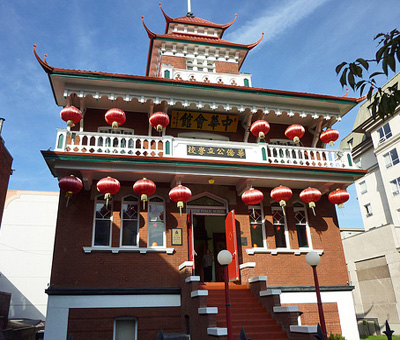Victoria's Chinatown National Historic Site of Canada
Victoria, British Columbia

Detail view
© Parks Canada Agency / Agence Parcs Canada, Andrew Waldron, 2011.
Address :
Pandora, Fisgard, Government, Herald Streets, Victoria, British Columbia
Recognition Statute:
Historic Sites and Monuments Act (R.S.C., 1985, c. H-4)
Designation Date:
1995-11-24
Dates:
-
1875 to 1923
(Construction)
-
1858 to 1923
(Significant)
Event, Person, Organization:
-
Kwong Lee
(Person)
-
Tai Soong
(Person)
-
Yang Wo Sang
(Person)
-
Chinese Canadians
(Organization)
-
Chinese Consolidated Benevolent Association
(Organization)
-
D.C. Frame
(Architect)
-
John Teague
(Architect)
Other Name(s):
-
Victoria's Chinatown
(Designation Name)
Research Report Number:
1988-036, 1995-030, 2005-SDC/CED-065
Plaque(s)
Existing plaque: Fisgard Street near Fan Tan Alley Pandora, Fisgard, Government, Herald Streets, Victoria, British Columbia
The oldest and most intact Chinatown in Canada, this district represents an important chapter in the complex history and heritage of Chinese Canadians. As the major immigrant port of entry on the west coast before World War I, Victoria boasted the largest concentration of Chinese Canadians in the country. They established a self-contained and identifiable neighbourhood which offered a complete range of commercial, residential and social amenities. Focused on Fisgard Street, it was made accessible by a distinctive layout of alleys and passageways. Its cohesive groupings of buildings adapted standard forms and designs found elsewhere in the city. Their flared temple-styled roofs, inset and projecting wrought-iron balconies, additional "cheater" storeys, interior courtyards, and brightly hued tiled overhangs give the area its distinctive character. Victoria's Chinatown is a richly textured reminder of the early years of Chinese settlement in Canada.
Description of Historic Place
Victoria’s Chinatown is an identifiable neighbourhood of tightly built primarily two and three-storey mixed-use brick buildings in a three-block area of downtown Victoria, British Columbia. Focussed on Fisgard Street, its interior is accessed by a distinctive layout of alleys and passageways. The cohesive grouping of buildings adapts standard forms found elsewhere in the city, decorated with flared temple-style roofs, inset and projecting wrought-iron balconies, interior courtyards and brightly hued tiled overhangs. A ceremonial entry arch was erected as part of a 1980s revitalization program. The official recognition refers to two nodes comprising some 33 buildings and the open spaces between them.
Heritage Value
Victoria’s Chinatown was designated a national historic site of Canada because: it is the oldest surviving Chinatown in Canada; it was the largest urban centre of Chinese population in Canada through the first decade of the twentieth century; it is one of a very few Chinatowns in North America to retain cohesive groupings of high heritage value and is dominated by its historical buildings.
The heritage value of this site is embodied in the diverse collection of structures within the district, their spatial connections, and ongoing role in commercial, social and institutional activities of the Chinese Canadian community. It speaks to the fact that, for nearly three decades before the Canadian Pacific Railway was completed, Victoria was the first port of entry of most Chinese immigrants and remained an important enclave until after World War II.
Source: Historic Sites and Monuments Board of Canada, Minutes, November 1995.
Character-Defining Elements
Key elements contributing to the heritage value of this site include:
the plan, incorporating the standard grid of urban blocks with interconnecting interior alleyways; placement of most buildings tight to the sidewalk, usually abutting one another; one and two-storey brick tenement buildings within the inner core area; the predominance of brick construction; typically Italianate-inspired, rectilinear massing of two to three-storey, flat-roofed buildings, with large ground-floor shop windows, and upper floors with doorways originally opening onto balconies; surviving balconies; occasional use of Chinoiserie motifs including upturned eaves and tiling, and detailing such as roof ornaments, domes, prominent parapets, pressed metal cornices and flagpoles; more elaborate 20th-century designs as illustrated by the Chinese Public School with its square massing elaborated with decorative balcony, upturned overhanging eaves with heavily worked bracketing and roof-top “pagoda” lantern, and the Gee Tuck Tong Benevolent Association Building with recessed upper floor balcony and “cheater storey” inserted between ground and second floors; post-1900 buildings with an internal corridor accessing an inner core area; reinforcing late 20th-century buildings including the Chinatown Care Centre and the Chung Wah Mansion housing complex.